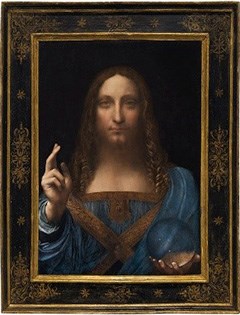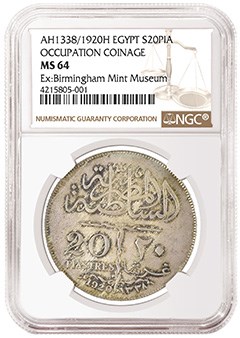Maybe Leonardo da Vinci Can Help the Rare Coin Market
Posted on 11/30/2017
By
Jeff Garrett
A couple of weeks ago, the world was shocked when a painting by the great Renaissance artist Leonardo da Vinci sold for $450,300,000. The price shattered the previous record for a work of art, Picasso’s “Women of Algiers,” which traded hands for $179 million in 2015.
 |
| "Salvator Mundi," by Leonardo da Vinci, sold for $450.3 million in November 2017 |
Some have speculated the $450 million price is more than anyone has ever paid for anything other than real estate. One writer noted that the amount paid would be a stack of $100 bills higher than the Empire State Building.
The sale raises many questions. Was the price rational in any way, and does it impact the rare coin market?
Bragging rights?
First, let’s examine the question of the sale making any sense from a financial standpoint. No matter how much money you have, this purchase would make a serious dent in your net worth. There are, however, a lot of billionaires in the world. Many have wealth exceeding 11 digits, or $10 billion. Status among this elite group is obviously an elusive objective, and what better way to say you’re wealthy than by owning the most expensive piece of art in the world.
Great art has been associated with the upper class and royalty for hundreds of years. There is little doubt that the purchase of Leonardo’s “Salvator Mundi” was made without at least some consideration of the fame and status it would bring, even among their peers.
Philanthropy?
ArtPrice, an online art registry of selling prices and commentary of art, made an interesting observation about the rational of the Leonardo da Vinci painting. They speculate that the piece may have been purchased for one of the many new museums that have been created around the world in the last twenty years. According to ArtPrice, there have been more museums opened in the world since the year 2000 than in the period from 1800 to 2000.
A great example in the United States in the Crystal Bridges Museum founded by the Walton family (Walmart), in Bentonville, Arkansas. This museum has been the biggest buyer of American art for several years. The new Museum of the Bible in Washington, D.C., is stocked with about $500 million of artifacts purchased in just the last few years by Steve Green, the president of Hobby Lobby.
The purchase of the da Vinci painting could be monetized somewhat by the incredible draw of having the world’s most expensive piece of art on display. Interestingly, the museum angle does have an application with the rare coin hobby.
A few years ago, I assisted in the purchase of a complete set of NGC-graded Dahlonega gold coins (1838-1861). The collector tremendously enjoyed the pursuit of these interesting coins. His reason for assembling the collection was to donate them to his alma mater, the University of Georgia. The collection is now on display in the Library Museum, and will help promote the hobby for generations to come.
The numismatic display at the Smithsonian Museum of American History also contains many coins that were purchased with donation to that museum being the ultimate goal. Perhaps this idea can be promoted to more coin collectors going forward. There are many numismatic museums that would love to have trophy items to promote foot traffic and numismatic education.
Portable wealth?
It has also been speculated that the purchase of the da Vinci painting was done because of the portable wealth it provides. There are many countries with individuals who have enormous wealth, but lack the legal protections found in the United States. A great example was the recent roundup of royals and billionaires in Saudi Arabia. One day you are living like a king, and next you are under house arrest for corruption.
Having wealth in a portable form in another country does make sense for many in this situation. I can think of few items that fit the definition of portable wealth better than rare coins. There are a lot of coins worth in excess of $1 million, and they are small and easy to transport.
Clever marketing?
The sale of the Leonardo da Vinci painting is also very interesting from a marketing perspective. The auction house Christie’s was very creative and aggressive promoting the sale of what they called “the last da Vinci” (because it was believed to be the last da Vinci in private hands). The painting toured the world, and was heavily marketed to the buyers who have paid staggering sums in the past for modern and contemporary art.
 |
 |
| These two coins are each examples where only two are known, and the other specimen is in a museum. LEFT: A Spanish 1695 Royal 8 Escudos, graded NGC MS 65. Read more. RIGHT: A 1920H Egypt 20 Piastres, graded NGC MS 64. Read more. Click images to enlarge. |
|
The painting was sold during the company’s contemporary art sales instead of the usual Old Masters auction sales. The painting also had a third-party guarantee of over $100 million to start the bidding. Stack’s Bowers made similar efforts when they sold the Pogue collection by partnering with Sotheby’s and holding most of the sales in New York City. The hope was to attract some of the players in the high-end art and collectibles market.
I believe there is no doubt that the sale of the Leonardo da Vinci painting for nearly half a billion dollars has reset the art market’s price scale. The same metrics shook the rare coin market when an example of the 1794 Silver Dollar sold for over $10 million in 2013. There is a lot of money in the world, and the prices for the best of the best have gone up. Average and much lesser works of art and rare coins have waned in the last few years, but the chase for the finest continues among the mega-rich.
Safer than the stock market?
There is also a continued search among well-heeled collectors of art and rare coins for someplace to invest their money. Interest rates have remained extremely low, and many feel uncomfortable with stocks at historic highs. I can assure you that rare coins have been on the radar of wealthy collectors in recent years. There have been several collectors who have invested over $100 million in their collections in the last 5-10 years.
Collectors also currently dominate the market for lower-priced rare coins. The supply and demand factor, however, favors buyers at the moment for less than the best. Investors for mid-market rare coins has been soft in recent years — thus, the lower prices seen for many series.
They say “a rising tide lifts all boats” and hopefully the fact that a collector of anything paid $450 million for an object will make some consider rare coins to be the bargain many of us think they are.
Want to see more articles like this? Subscribe to the free NGC Weekly Market Report.
Stay Informed
Want news like this delivered to your inbox once a month? Subscribe to the free NGC eNewsletter today!
